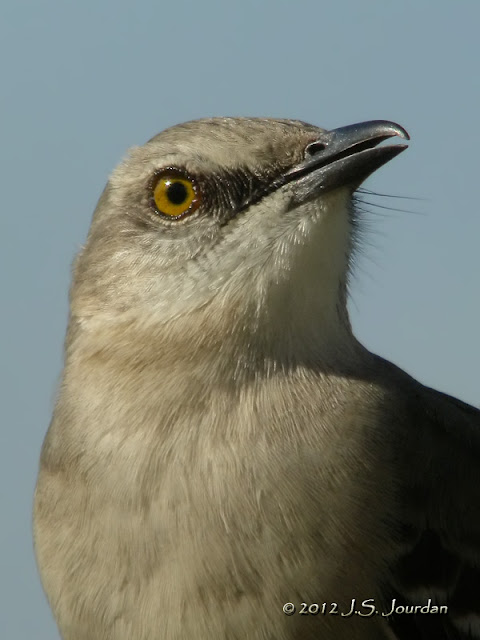Digiscoping Florida! - 28 Jan 2012
Early Friday morning we drove back to Lakeland, taking the Florida Turnpike a good part of the way. On our way down to West Palm I had the opportunity to scan dozens of Osprey, Black Vultures and Turkey Vultures from the car. I even managed to see a Snail Kite hovering over a local reservoir near Port St. Lucie. During our 2.5 hour trip back to Lakeland I managed to see 6 Crested Caracaras, several Red-tailed Hawks, and a Loggerhead Shrike.
A video of the Little Blue Heron was cut short by a phone call reminding me that the Friday nite Fish Fry was about to start.
Saturday morning Robin and I grabbed our gear and headed out to the Circle B Bar Reserve in Lakeland. Skies were clear, and temps were going to be in the 70's, so I was looking forward to getting in some digiscoping. A screeching Red-shouldered Hawk heralded our arrival, and I was able to locate it about 70 yds. out in the marsh. Turkey Vultures, Black Vultures, and Wood Storks were kettling high over the marsh, while Sandhill Cranes, Limpkins, Black-bellied Whistling Ducks, and Boat-tailed Grackles could be heard from several locations all around us.
Everyone seemed to be carrying camera equipments and big lenses. I talked with several birders/photographers who preferred this place to Ding Darling NWR. One person had just spent the last 2 hours photographing a Sora, and directed me to an area along the shoreline just a few yards away. There, I found a photographer photographing the bird just 2' away. Try as I might though, I couldn't see it! Talk about blending in to one's surroundings.
I finally spotted the Sora, and quickly began 'trying' to digiscope it. Though it was out in the open, the tiny rail was frenetically foraging, so I had to time the press of the shutter of the Coolpix P6000 to capture a momentary pause. At only 0.6 fps the P6000 is not good a capturing fast-moving subjects. For the next half-hour I shot almost 200 frames, managing to get many sharp-focused images of the rail's backside, frontside, and sometimes even the head and eyes. This was a time when I wished that I didn't have the 45X Wide Eyepiece on the Zeiss 85T*Fl, as I was trying to capture a fast-moving bird that completely filled my field-of-view from just 20' away.
Still, I managed to get many satisfying keepers, and even a short video. Click on this link for a short slideshow!
Circle B Bar Reserve, Polk, Florida, US
Jan 28, 2012 8:00 AM - 12:00 PM
Protocol: Traveling
3.0 mile(s)
33 species
Black-bellied Whistling-Duck (Dendrocygna autumnalis) 6
Blue-winged Teal (Spatula discors) 12
Wild Turkey (Meleagris gallopavo) 1
Sora (Porzana carolina) 1
Common Gallinule (Gallinula galeata) 3
American Coot (Fulica americana) 100
Limpkin (Aramus guarauna) 2
Sandhill Crane (Antigone canadensis) 2
Wood Stork (Mycteria americana) 6
Anhinga (Anhinga anhinga) 2
Double-crested Cormorant (Nannopterum auritum) 12
Little Blue Heron (Egretta caerulea) 1
Snowy Egret (Egretta thula) 3
Western Cattle Egret (Bubulcus ibis) 6
Great Egret (Ardea alba) 1
White Ibis (Eudocimus albus) 4
Glossy Ibis (Plegadis falcinellus) 6
Roseate Spoonbill (Platalea ajaja) 2
Black Vulture (Coragyps atratus) 12
Turkey Vulture (Cathartes aura) 12
Osprey (Pandion haliaetus) 6
Snail Kite (Rostrhamus sociabilis) 1
Northern Harrier (Circus hudsonius) 1
Red-shouldered Hawk (Buteo lineatus) 1
Red-tailed Hawk (Buteo jamaicensis) 2
Barred Owl (Strix varia) 2
Red-bellied Woodpecker (Melanerpes carolinus) 1
Pileated Woodpecker (Dryocopus pileatus) 1
Crested Caracara (Northern) (Caracara plancus cheriway) 1
Loggerhead Shrike (Lanius ludovicianus) 2
House Wren (Troglodytes aedon) 1
Sedge Wren (Cistothorus stellaris) 1
Northern Mockingbird (Mimus polyglottos) 1
View this checklist online at https://ebird.org/checklist/S4
This report was generated automatically by eBird v3 (https://ebird.org/home)
Jan 28, 2012 8:00 AM - 12:00 PM
Protocol: Traveling
3.0 mile(s)
33 species
Black-bellied Whistling-Duck (Dendrocygna autumnalis) 6
Blue-winged Teal (Spatula discors) 12
Wild Turkey (Meleagris gallopavo) 1
Sora (Porzana carolina) 1
Common Gallinule (Gallinula galeata) 3
American Coot (Fulica americana) 100
Limpkin (Aramus guarauna) 2
Sandhill Crane (Antigone canadensis) 2
Wood Stork (Mycteria americana) 6
Anhinga (Anhinga anhinga) 2
Double-crested Cormorant (Nannopterum auritum) 12
Little Blue Heron (Egretta caerulea) 1
Snowy Egret (Egretta thula) 3
Western Cattle Egret (Bubulcus ibis) 6
Great Egret (Ardea alba) 1
White Ibis (Eudocimus albus) 4
Glossy Ibis (Plegadis falcinellus) 6
Roseate Spoonbill (Platalea ajaja) 2
Black Vulture (Coragyps atratus) 12
Turkey Vulture (Cathartes aura) 12
Osprey (Pandion haliaetus) 6
Snail Kite (Rostrhamus sociabilis) 1
Northern Harrier (Circus hudsonius) 1
Red-shouldered Hawk (Buteo lineatus) 1
Red-tailed Hawk (Buteo jamaicensis) 2
Barred Owl (Strix varia) 2
Red-bellied Woodpecker (Melanerpes carolinus) 1
Pileated Woodpecker (Dryocopus pileatus) 1
Crested Caracara (Northern) (Caracara plancus cheriway) 1
Loggerhead Shrike (Lanius ludovicianus) 2
House Wren (Troglodytes aedon) 1
Sedge Wren (Cistothorus stellaris) 1
Northern Mockingbird (Mimus polyglottos) 1
View this checklist online at https://ebird.org/checklist/S4
This report was generated automatically by eBird v3 (https://ebird.org/home)
























Comments
Post a Comment
Please leave a comment. I will try to respond ASAP.